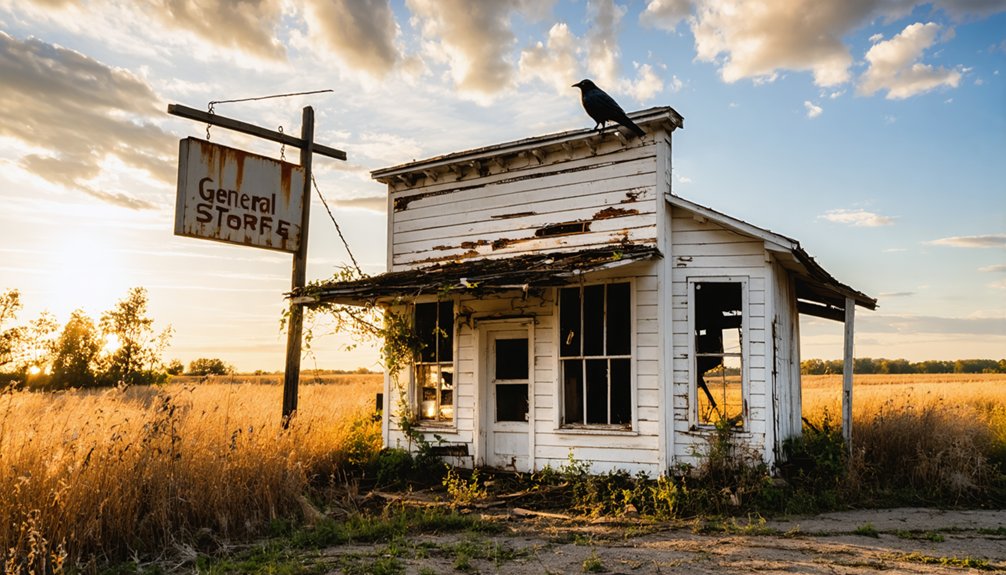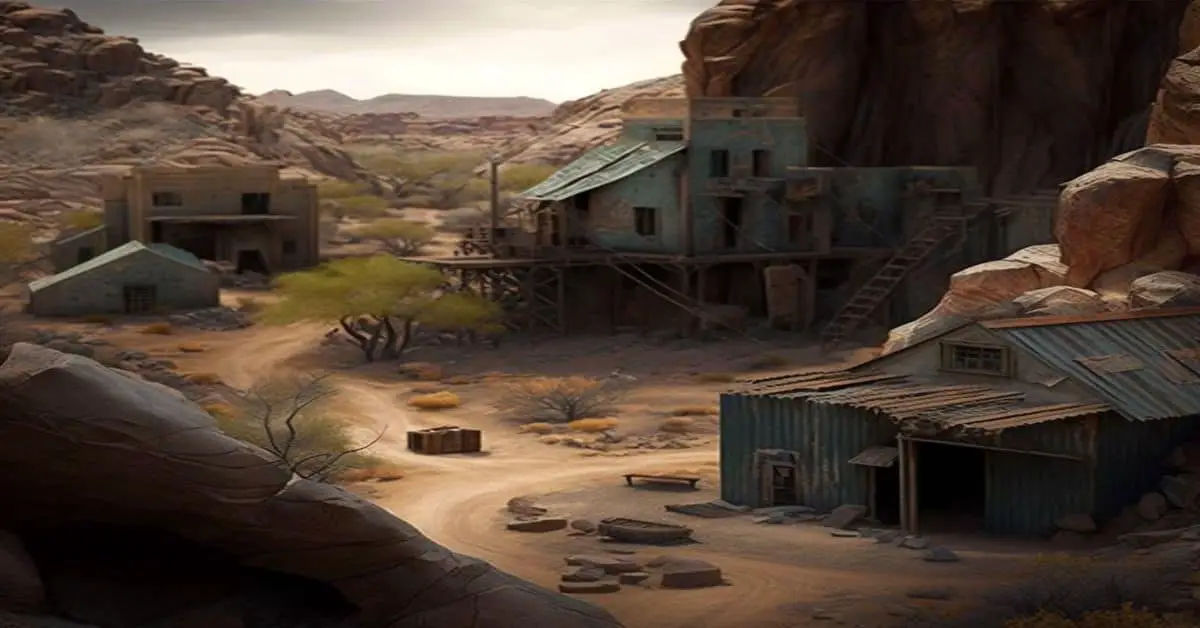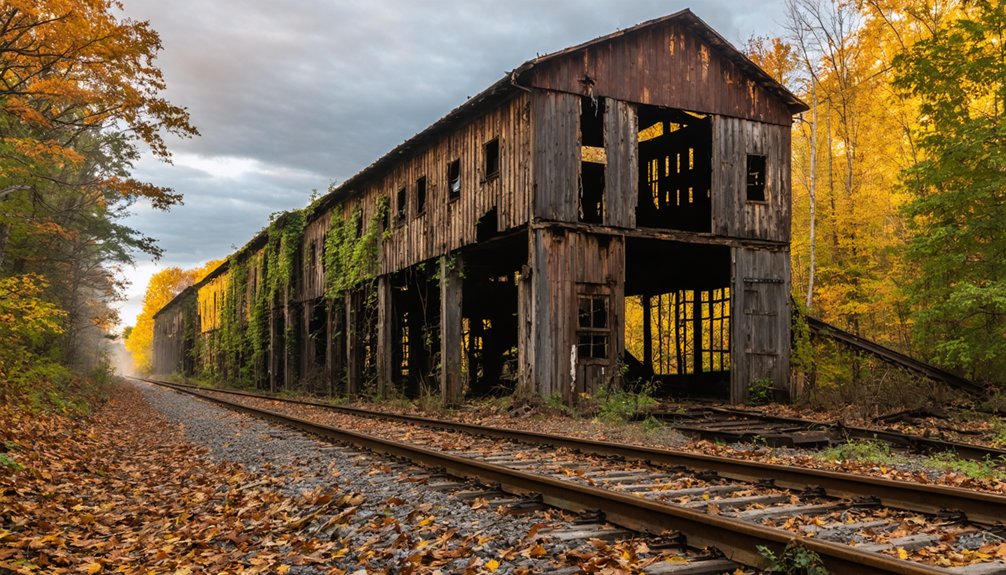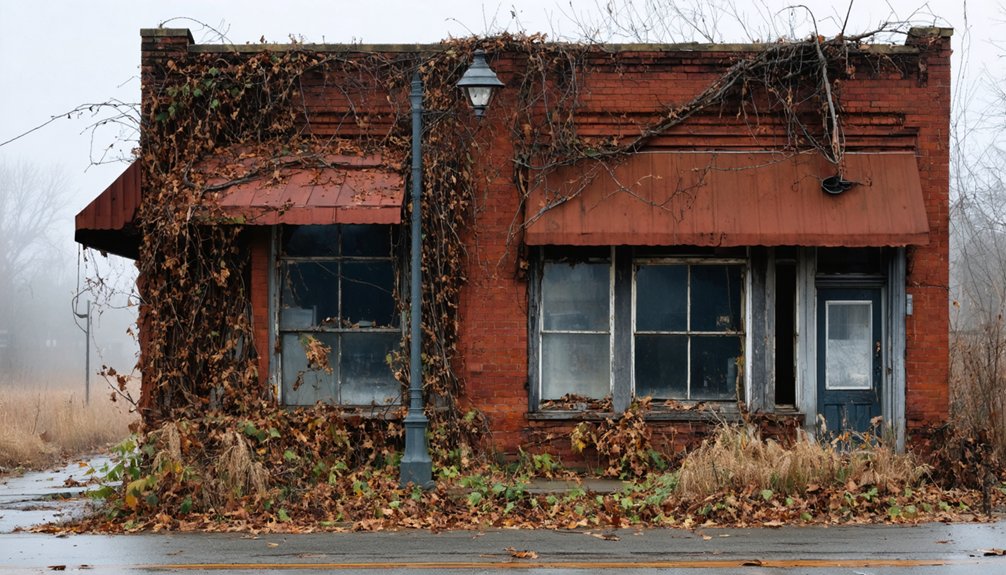You’ll find Chesapeake’s ghostly remains two miles east of Marshfield in Steuben Township, Indiana, where a once-bustling river settlement stood from 1834. This frontier community thrived on tobacco farming and river trade until the railroad’s bypass triggered its decline. Today, scattered brick fragments, mill ruins, and weathered foundations peek through the forest floor, while local legends tell of Henry Dixon’s spectral lantern haunting the abandoned tunnels – just one piece of this vanished town’s fascinating story.
Key Takeaways
- Chesapeake was established in 1834 in Steuben Township, Indiana, as a bustling river community with essential services and commercial activities.
- The town’s decline began when railroads bypassed it, leading to decreased river commerce and eventual abandonment of businesses and homes.
- Archaeological remains include foundation sites, mill structure ruins, colonial ceramics, and scattered brick fragments beneath the forest floor.
- The ghost town’s physical traces feature weathered stone fragments, mill technology remnants, and visible depressions indicating water management systems.
- Local folklore includes ghost stories, particularly about Henry Dixon’s spectral lantern near abandoned railway tunnels.
The Rise of a River Settlement
While Native American tribes had thrived along the region’s waterways for millennia, European settlement of the Chesapeake area began in earnest during the early 1500s.
You’ll find that river navigation played an essential role in shaping settlement strategies, as newcomers quickly recognized the advantages that indigenous peoples had long understood. These waterways provided sustenance, transportation, and defense capabilities that you couldn’t find elsewhere. Captain John Smith’s explorations in 1608 documented thirteen Indian villages along the Potomac River.
Following the examples of the Chesepian, Powhatan, and Piscataway peoples, settlers established communities near fertile riverbanks where they could farm, fish, and trade. By 1600, thirty to forty-five thousand Indians inhabited the Chesapeake region, maintaining a balanced lifestyle of agriculture and hunting.
They adapted to the landscape much as Native Americans had done, though their approach to resource management differed markedly. This pattern of settlement would lay the groundwork for the region’s development, even as colonial expansion brought inevitable conflicts between European and indigenous populations.
Daily Life in Early Chesapeake
Life in early Chesapeake revolved around the rhythms of its waterways and the demands of frontier survival.
You’d find yourself living in a log cabin or simple wood-frame home near the river, sharing space with extended family, servants, or enslaved workers. Your daily chores would include tending to tobacco fields and household gardens, while preserving food through smoking and salting for the winter months ahead.
Family gatherings often centered around religious meetings in homes or small churches, where you’d strengthen community bonds essential for survival. The Algonquian-speaking tribes were among the earliest inhabitants of the region, shaping its cultural landscape.
Trade patterns with Native Americans gradually shifted from exchanging blue and white beads to darker colors, reflecting changing relationships between communities.
You’d trade with neighbors and Native Americans, participate in town meetings, and rely on mutual aid for building projects and protection. Your children would learn through hands-on work, helping with farm tasks while receiving basic education at home or through apprenticeships.
Economic Foundations and Trade Routes
During its heyday, Chesapeake’s economy thrived on its strategic location along the Mississinewa River, where you’d find bustling grain mills and agricultural trade operations.
The town’s economic sustainability depended on essential trade partnerships with nearby settlements, fostering a network of commerce that extended beyond local boundaries. Similar to how tobacco cultivation revolutionized trade in early America, these commercial networks were crucial to regional prosperity. Much like Indiana Rail Road Company operations elsewhere in the state, these trade connections were vital to the region’s growth.
You’ll appreciate how Chesapeake’s enterprising spirit shaped its development:
- River ports served as lifelines for grain processors and farmers, connecting them to broader markets.
- Local mills transformed harvested crops into valuable commodities, creating jobs and wealth.
- Merchant networks established along the Mississinewa helped secure the town’s position as a regional trade hub.
However, when railroads began redirecting commerce away from river routes, Chesapeake’s once-prosperous economy faced mounting challenges that would ultimately contribute to its decline.
The Path to Abandonment
Chesapeake’s economic foundation began crumbling when the railroad bypassed the town in favor of more profitable routes, causing river-based commerce to steadily decline in the late 1800s.
You’ll find that this transportation shift triggered a cascade effect, where local businesses shuttered and families relocated to railroad-connected towns with better prospects. Much like the town of Wehrum mining settlement, which once boasted 230 houses before being completely abandoned.
As schools and mills closed, the remaining population gradually departed throughout the early 1900s, leaving Chesapeake’s buildings to deteriorate into the ruins you can spot today. Like other settlements along waterways, Chesapeake’s fate mirrored that of river port settlements Clifton and Georgeville, which vanished after railroads became the dominant transportation mode.
Economic Decline Patterns
While many colonial settlements faced economic challenges, the path to Chesapeake’s abandonment followed a distinct pattern rooted in its agricultural foundation.
The town’s lack of economic resilience stemmed from its heavy reliance on tobacco monoculture, which rapidly depleted the soil. Without agricultural sustainability practices, the community found itself trapped in a cycle of diminishing returns. The absence of diverse food production strategies, as seen in more successful colonial settlements, accelerated the town’s decline. The creation of Brown County Park in 2019 further limited access to the area.
- You’ll find evidence of the settlement’s dependency on export markets, making it vulnerable to price fluctuations and overseas demand shifts.
- You can trace how the shift from indentured servants to enslaved labor discouraged innovation and economic diversification.
- You’re able to see how the absence of local manufacturing left the community exposed to devastating supply chain disruptions.
The town’s fate was sealed by its inability to adapt when soil exhaustion and market changes struck simultaneously.
Transportation Routes Changed
As transportation networks evolved across Indiana in the early 20th century, Chesapeake’s fate became intertwined with shifting rail and road configurations that gradually isolated the town.
You would’ve witnessed the transportation evolution firsthand – from the discontinuation of the Hammond Belt Railway connection to Chicago, to the rerouting of essential state roads like SR 135 that bypassed smaller communities.
The rail infrastructure that once defined Chesapeake’s connectivity crumbled as major carriers like Norfolk Southern and CSX withdrew their services.
The removal of rail diamonds and bridges severed critical links, while the conversion of power plants from coal to natural gas diminished freight traffic.
When highways expanded and interstates like I-465 redirected traffic flows, you’d have seen Chesapeake’s role as a transportation hub fade into obscurity.
Population Exodus Timeline
During the early days of settlement in 1834, you’d have found a bustling community taking shape in Steuben Township, with Chesapeake’s initial population drawn to its strategic location two miles east of present-day Marshfield.
While exact population growth figures aren’t documented, the establishment of essential services like the country store and blacksmith shop suggests an optimistic beginning for early settlers.
The migration trends that led to Chesapeake’s eventual abandonment followed this pattern:
- Initial wave of settlers establishing homes and businesses around 1834
- Gradual decline as township meetings and commercial activities decreased
- Final exodus marked by the closure of the schoolhouse and remaining businesses, leading to complete abandonment
Today, you’ll find no trace of the once-promising settlement that pioneered Steuben Township’s development.
Physical Remains and Archaeological Findings
If you walk through Chesapeake’s abandoned grounds today, you’ll find scattered brick fragments and pipe stems dating to the 1660-1715 period nestled beneath the forest floor, marking where buildings once stood.
Archaeological surveys have documented foundation sites and post stains indicating former wooden structures, while larger pit features suggest the remnants of colonial-era cellars.
The most prominent physical traces you’ll encounter are mill structure ruins, which match typical assemblages of colonial ceramics, glass, and nails found at adjacent historic sites in the region.
Foundation Sites Today
While decades of abandonment have taken their toll, the foundation sites of Chesapeake, Indiana now reveal little more than faint traces of the town’s former existence.
You’ll find that environmental factors and minimal foundation preservation efforts have left these historical remains barely visible to the untrained eye. Archaeological challenges, including erosion and vegetation growth, continue to threaten what’s left of this once-thriving community.
When you explore these grounds, you’ll encounter:
- Weathered stone fragments that once supported family homes and businesses
- Scattered remnants of daily life slowly being reclaimed by nature
- Hidden structural footprints that tell stories of the town’s layout
Despite the physical decay, these foundation sites remain essential pieces of Indiana’s cultural heritage, offering valuable insights into the region’s past communities and their way of life.
Mill Structure Remnants
Among the most significant ruins at Chesapeake’s site, you’ll find the weathered remains of its once-bustling mill complex.
The stone foundation, built to withstand the pressures of heavy mill stones and water-powered machinery, has endured while wooden upper structures have long since vanished. You can still spot remnants of industrial craftsmanship in the scattered metal components – corroded wheel axles, riveted steel fragments, and gear pieces that showcase the era’s mill technology.
The site reveals clues about water management through visible depressions where mill races once channeled creek flow to power the wheels.
Near the mill ruins, you might notice concrete pedestals and worn headstones, silent reminders of the community that once thrived around this industrial hub.
Historic Building Materials
The remains of Chesapeake’s historic buildings offer limited physical evidence of the town’s construction materials, though archaeological research suggests typical early Indiana settlement patterns.
Local building techniques likely relied on readily available material sources, including timber from the surrounding woodlands and stone from nearby quarries. You’ll find that the town’s structures, including its store, blacksmith shop, and schoolhouse, would have followed common frontier building practices of the 1830s.
- The proximity to Chesapeake Creek means you might discover waterlogged remnants of wooden foundations that tell stories of the town’s early construction methods.
- You’re likely to find traces of locally-sourced limestone and fieldstone that were common in Warren County’s early settlements.
- Your exploration may reveal hand-forged nails and hardware from the blacksmith shop, indicating local metalworking capabilities.
Local Legends and Historical Legacy
Local legends surrounding Chesapeake’s ghostly remains have endured long after the town’s physical structures crumbled into Indiana’s landscape.
You’ll find haunting tales of spectral sightings tied to tragic deaths, including stories similar to Henry Dixon’s ghostly lantern that’s said to appear in abandoned railway tunnels nearby. These accounts blend seamlessly with documented history, creating a rich cultural significance that extends beyond mere ghost stories.
Like many Indiana ghost towns, Chesapeake’s legacy lives on through oral traditions that hint at untold violence and mysterious happenings.
While distinguishing fact from fiction can be challenging, the stories serve as a powerful reminder of how communities preserve their history.
You’re experiencing a piece of Indiana’s past that continues to captivate visitors and locals alike through these enduring narratives.
Frequently Asked Questions
Are There Any Surviving Photographs of Chesapeake From Its Active Period?
Through crumbling buildings and fading memories, you won’t find any confirmed historic documentation or visual artifacts showing Chesapeake’s active period. No surviving photographs have been discovered in public archives or collections.
What Safety Precautions Should Visitors Take When Exploring the Ghost Town Site?
Bring basic safety gear: flashlight, first aid kit, sturdy boots, and respirator. Don’t enter unstable structures, watch for debris, and stick to daylight hours. Always tell someone your exploration plans.
Who Were the Last Known Residents to Leave Chesapeake?
You won’t find documented records of the last residents who left this ghost town, though they were likely railway workers, farmers, or business owners connected to Delaware County’s transport industry.
Does Anyone Still Own the Land Where Chesapeake Once Stood?
You’ll find it challenging to pinpoint current land ownership of this long-silent ghost town, as records aren’t readily available and the property likely transferred quietly through private sales or county management.
Are There Any Annual Events or Celebrations Commemorating Chesapeake’s History?
You won’t find any official annual celebrations commemorating Chesapeake’s history. While regional ghost tours and seasonal events happen nearby, none specifically honor this Indiana ghost town’s unique past.
References
- https://en.wikipedia.org/wiki/List_of_ghost_towns_in_Indiana
- https://kids.kiddle.co/List_of_ghost_towns_in_Indiana
- https://www.thestarpress.com/story/news/local/2021/07/21/bygone-muncie-ghost-towns-lurk-around-delaware-county-indiana/8018338002/
- https://www.wikiwand.com/en/articles/List_of_ghost_towns_in_Indiana
- https://www.youtube.com/watch?v=45D4dbASJyE
- http://freepages.rootsweb.com/~gtusa/history/usa/in.htm
- https://indianacountyparks.org/our-trails/ghost-town-trail/ghost-town-trail-history/
- https://www.onlyinyourstate.com/experiences/indiana/ghost-towns-in
- https://southernspaces.org/2004/chesapeake-bay/
- https://www.aag.org/american-indians-of-washington-d-c-and-the-chesapeake/



